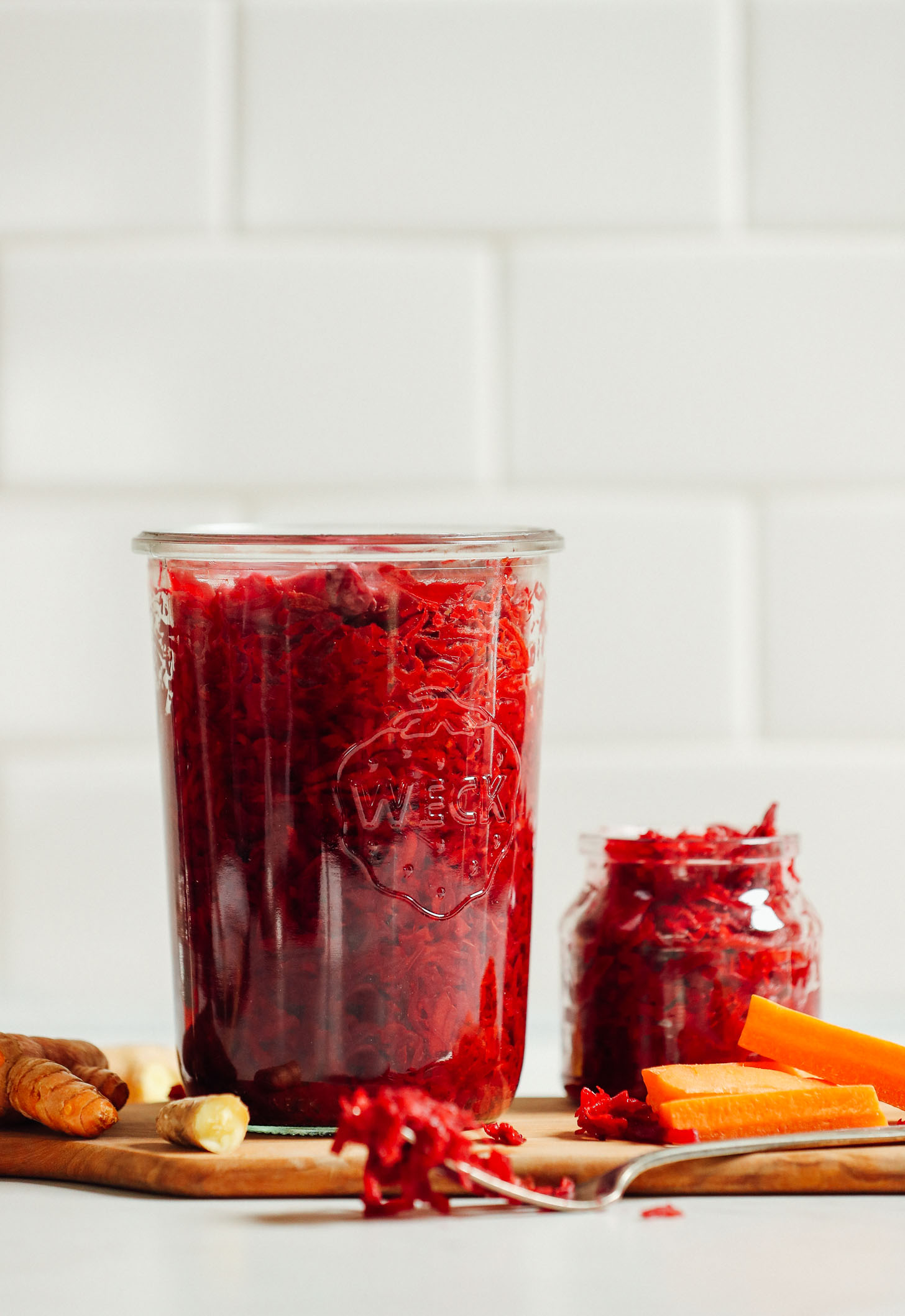
My first experience with sauerkraut was when I was working at a sandwich shop in college. The rule was if you showed up late you had to make the “sauerkraut.” It was kind of awful because the sauerkraut was pre-made and came in a giant can, and once you got past the smell, you had to mix it with mayonnaise. Needless to say, it was one of my least favorite tasks and a major motivator to get to work on time.
This sauerkraut, however, is nothing like that. It’s homemade from scratch with simple ingredients to help promote a healthy gut (and there’s no mayonnaise in sight). Plus, it’s super easy to master the technique and requires just 7 simple ingredients. Shall we?
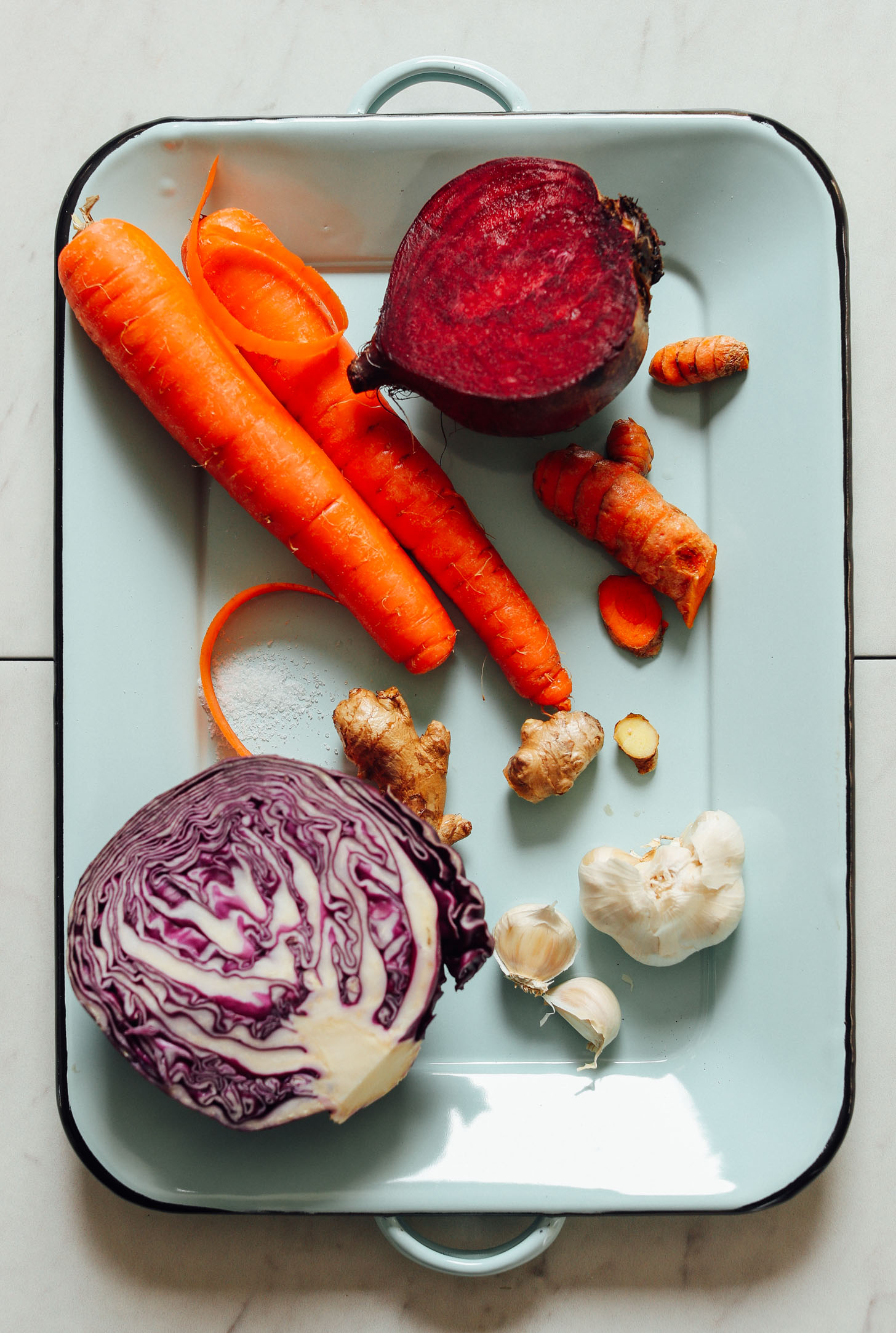
What is Sauerkraut?
Sauerkraut is a fermented food made from cabbage. It has been consumed for thousands of years for its probiotic benefits and is rich in vitamins C, B, A, K, and a variety of minerals.
It has a tangy flavor, crunchy texture, and is simple and cost-effective to make at home!
Origins of Sauerkraut
You may have heard that sauerkraut was a German invention, but that’s not necessarily true! Who knew!?
Instead, sauerkraut is thought to have originated in northern China. It made its way to Europe about 1000 years later and was eaten by Dutch seafarers as a way to prevent scurvy, due to sauerkraut’s vitamin C content. (source)
How to Make Sauerkraut
The simplest form of sauerkraut is just cabbage and salt, which is where we start in this recipe.
Once the salt is added, simply massage with clean hands for 10 minutes or until the cabbage has reduced quite a bit in size and released quite a bit of liquid at the base of the bowl. See the progression in the next two photos.
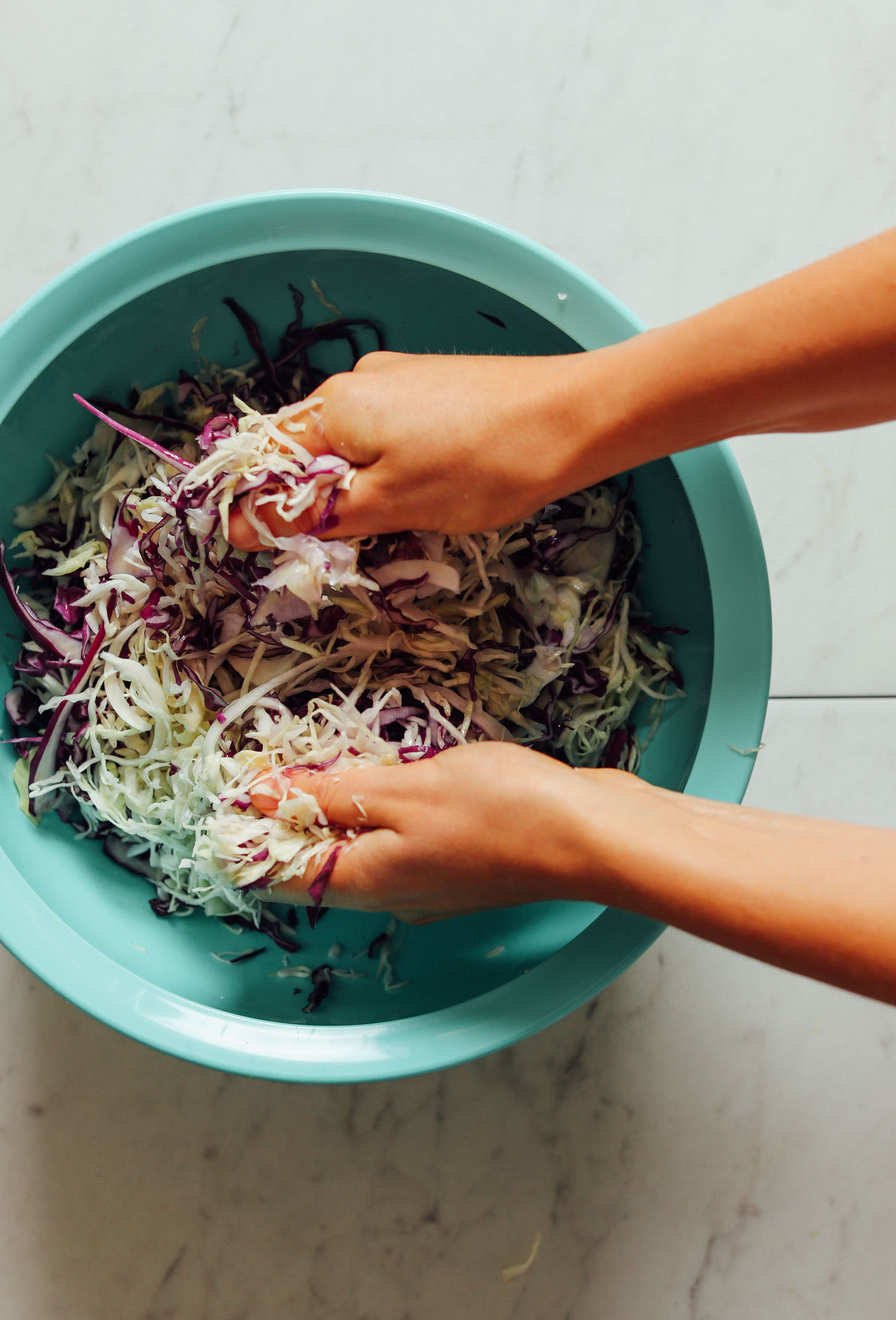
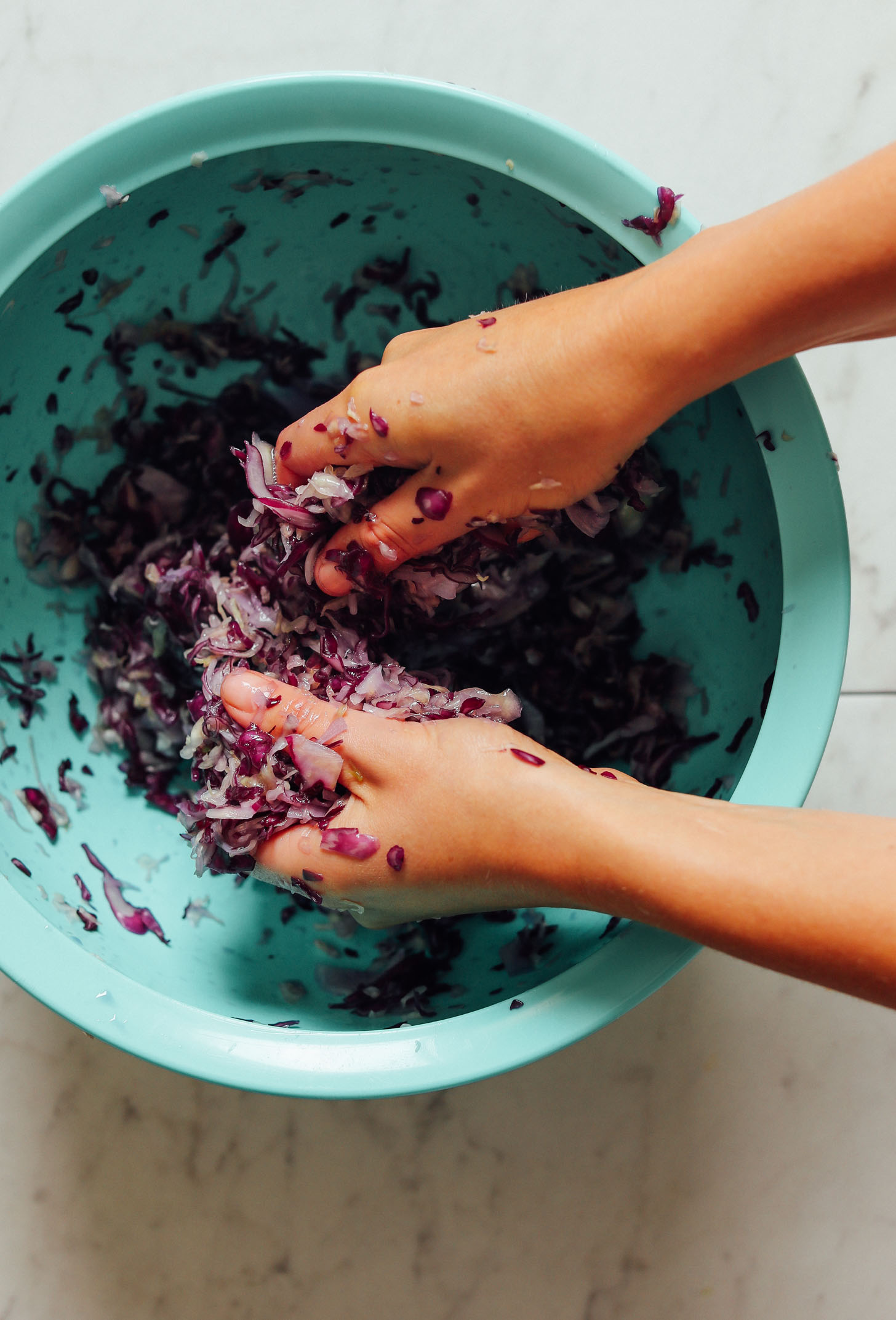
We’re looking good! Now, let’s add some color and flavor.
I went with shredded carrots and beets, which provide a vibrant orange-magenta hue. Next come fresh minced garlic and fresh grated ginger and turmeric for big flavor. The result is a perfectly salted fresh vegetable sauerkraut infused with zesty garlic and ginger and earthy turmeric. Swoon!
Mix again to incorporate and you’ve practically made sauerkraut!
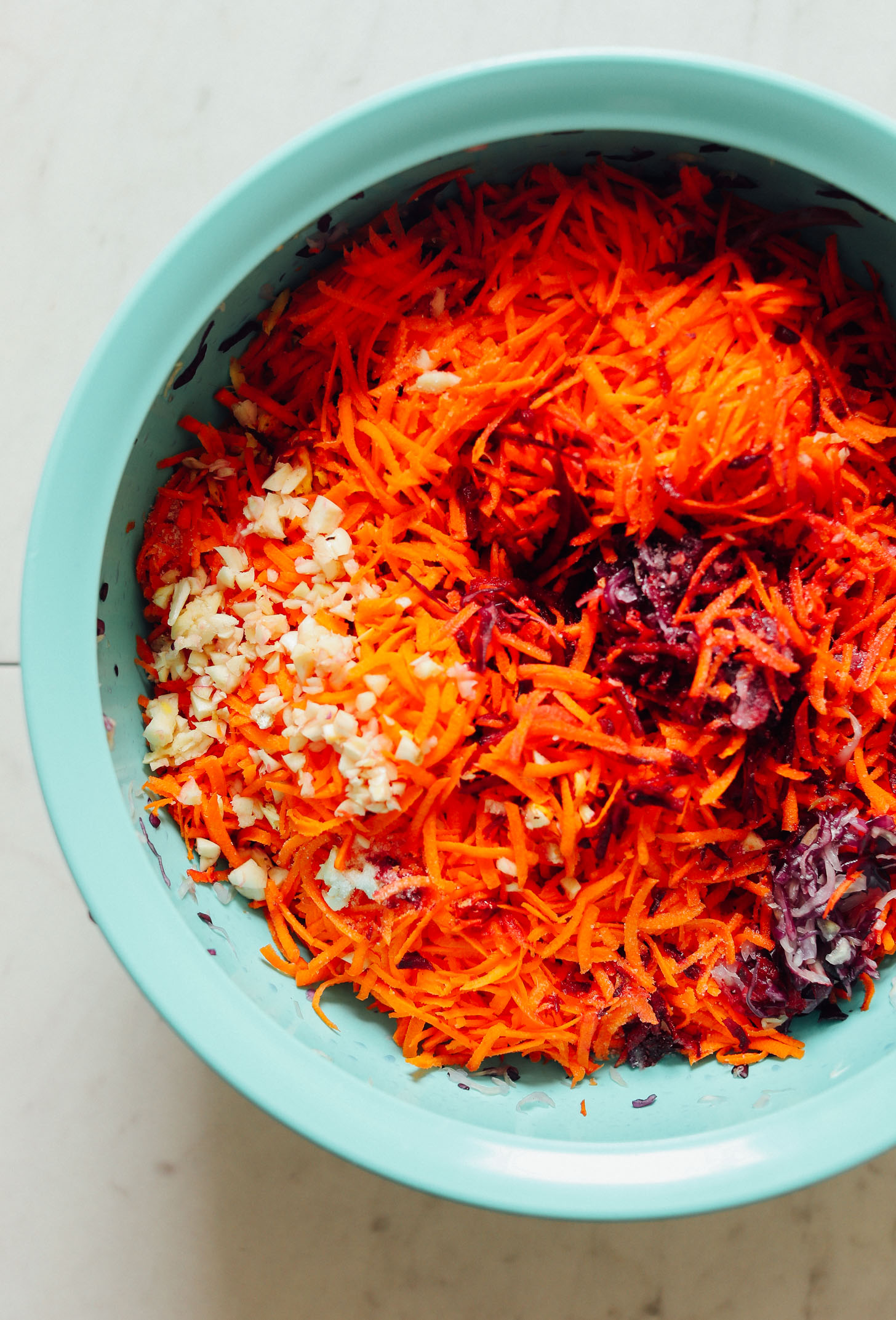
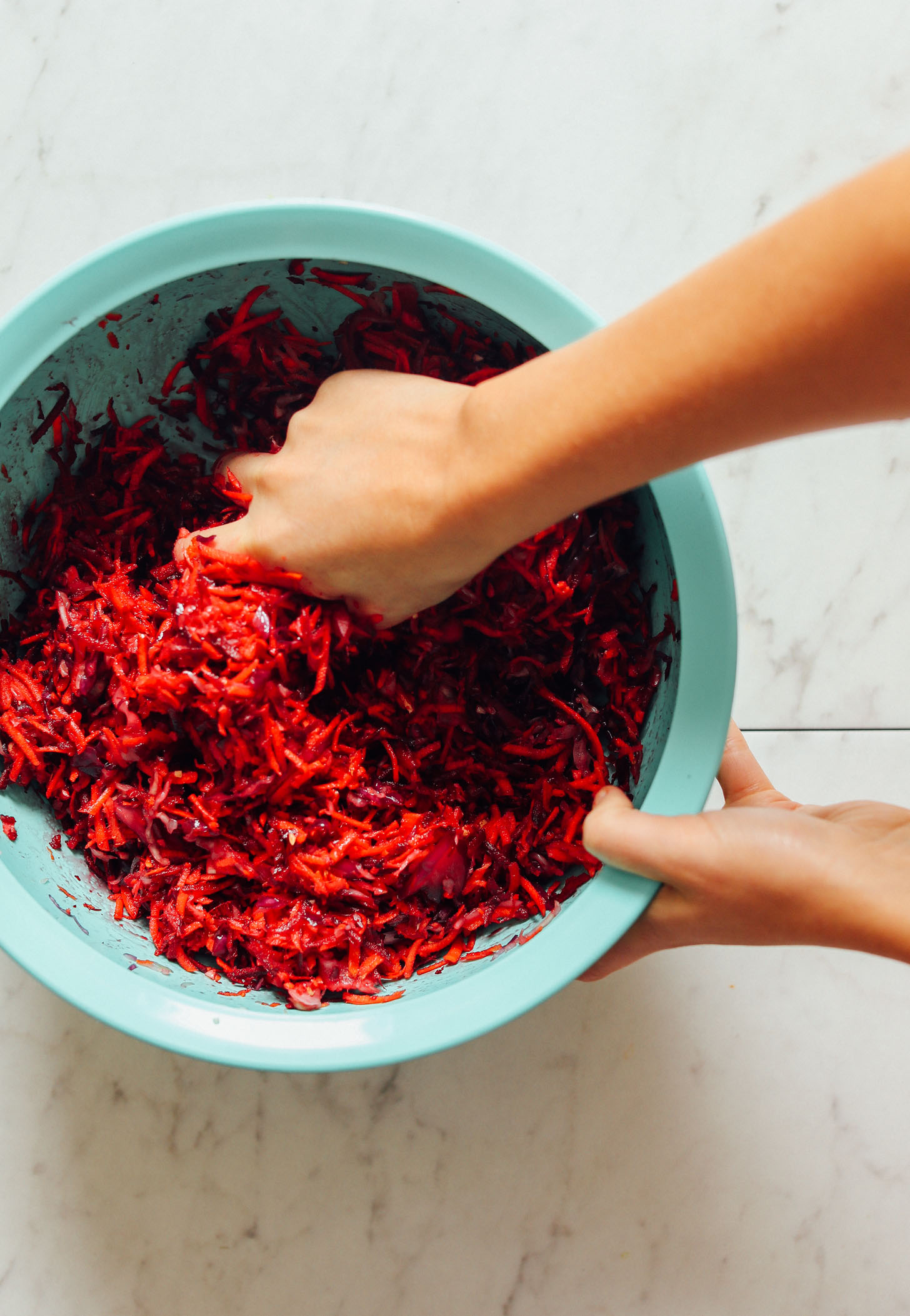
All that’s left to do is pack into sterilized jars and ensure the liquid extracted from all that massaging rises up and covers the kraut for optimum fermentation. Then leave it alone to do its thing. Set it on the counter out of direct sunlight or in a cabinet for 1-14 days (or longer) to let it naturally ferment.
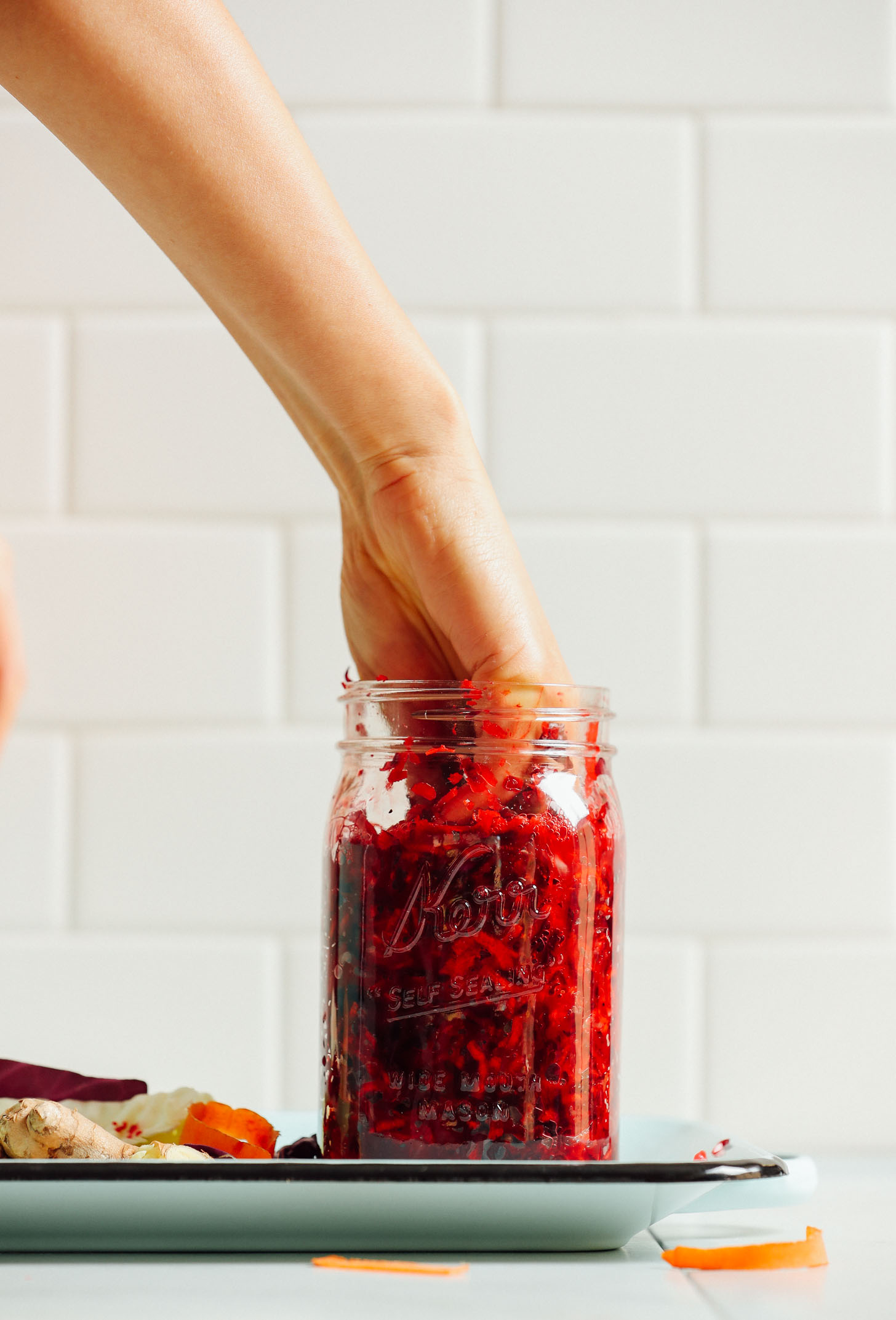
We hope you LOVE this kraut! It’s:
Tangy
Crunchy
Fresh
Filled with probiotics
Garlicky
& So delicious
This would make the perfect topper for sandwiches, salads, wraps, bowls, and more! Our favorite way to enjoy sauerkraut is with dishes like Kitchari or Garlicky Kale Salad with Crispy Chickpeas. But it’s even tasty right out of the jar (just don’t double dip to avoid contamination).
More Probiotic-Rich Recipes
If you’re into fermented things, be sure to also check out our Easy Vegan Kimchi, Mango Coconut Yogurt, Cultured Vegan Sour Cream, Probiotic-Cultured Vegan Cheese, and 2-Ingredient Coconut Yogurt!
If you try this recipe, let us know! Leave a comment, rate it, and don’t forget to tag a photo #minimalistbaker on Instagram. Cheers, friends!
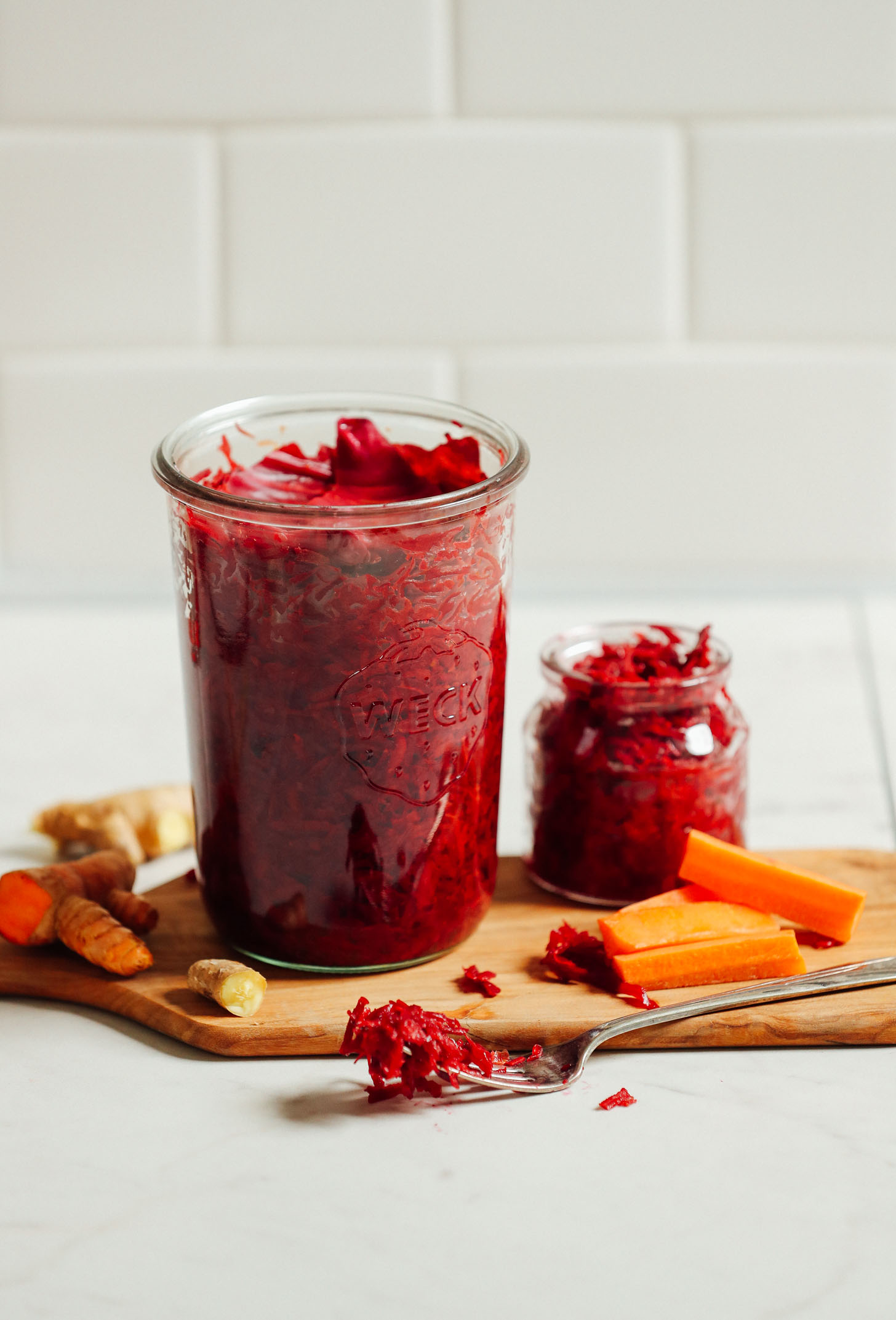
How to Make Sauerkraut
Ingredients
- 8 cups red or green cabbage (finely grated or chopped)
- 1 ½ – 2 tsp sea salt (plus more to taste)
- 1 small beet (finely shredded)
- 3 whole carrots (finely shredded)
- 3 Tbsp fresh ginger (shredded / grated)
- 3 Tbsp fresh turmeric (shredded / grated)
- 4 cloves garlic (finely minced)
Instructions
- Sterilize any equipment you will be using for fermentation, especially the jars (we prefer using mason jars or these Weck Jars that are about 850 ml). It is extremely important that everything is sterilized to allow for proper fermentation. Do so easily by pouring boiling water over clean jars and lids and drying completely. Let come back to room temperature before adding ingredients.
- Add finely grated cabbage (we used our mandolin) to a large mixing bowl and top with 1 ½ teaspoons sea salt (or the lower end of the suggested range if making a different batch size). Wash hands thoroughly and massage cabbage for ten minutes. The cabbage should start softening, shrinking in size, and releasing water (see photo). Continue massaging until this happens.
- Add shredded beet, carrot, ginger, turmeric, and garlic and massage once more with clean hands for 4-5 minutes until thoroughly combined (see photo). Then taste test and adjust flavor, adding more salt for saltiness, grated ginger for more zing, or garlic for more intense garlic flavor.
- Use your clean hands to put the sauerkraut mixture into your sterilized jars and press down firmly to pack. There should be enough liquid from the massaging to rise up and cover the vegetables. If this doesn’t happen, top with filtered water until covered (it is unlikely that you will need to add water).
- Also, make sure there is plenty of room (about 1 ½ inches) between the contents and the lid so it has room to expand. Seal with a lid and set on the counter where there’s not much direct sun exposure or in a cabinet. The ideal temperature for fermentation is above 65 degrees F (18 C), so try to keep your environment on the warmer side to encourage proper fermentation.
- Fermentation can happen as quickly as 24 hours if your space is hot, or it can take as long as 2 weeks, (again, depending on the environment). We found our sweet spot to be about 10 days.
- During this fermentation process, open your jars once per day to release air (you should feel pressure release and see air bubbles when you open the jars). Press down with a sterilized object such as a spoon or the bottom of a drinking glass to ensure that the vegetables are still completely covered in the liquid. Doing so helps encourage proper fermentation.
- The longer it sits and ferments, the tangier it will become, so sample occasionally with a clean utensil to test and see if it is at the right stage for you. Once it has reached the desired tanginess, cover securely and transfer to the fridge, where it should keep at least 3 months and up to 6 months. When serving, don’t double dip to avoid contamination.
Video
Notes
*Recipe as written makes enough to fill approximately 1 1/2 (850 ml) jars of sauerkraut.
*Prep time reflects time it takes to make recipe and let it ferment for 24 hours. However, fermenting up to 2 weeks may be necessary.
*Recipe and method inspired by lovely and talented Nina Montagne of Cam and Nina.
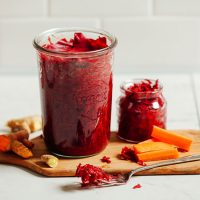
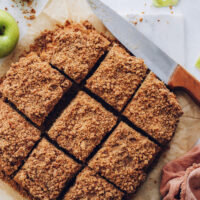
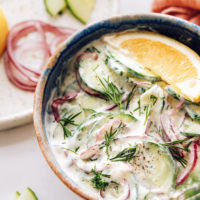
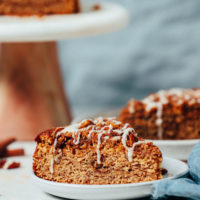




Sophie Elliott says
Delicious recipe! So bright and vibrant. It took a while to make and got pretty messy, but it was my first time, so hopefully it will be quicker and tidier in future!!
Thank you for sharing your experience, Sophie! We’re glad you enjoy the sauerkraut! xo
Emily says
Fab recipe thank you used up some cabbage and beets I’d grown, have made x2 jars and both seems to be going well after 48 hours, veg risen and I keep pushing it down. Do I need to wait 9 days?
We’re so glad you enjoy the recipe, Emily! We’d recommend taste testing and seeing if it’s reached your desired tanginess. If that’s before 9 days, then you can transfer to the refrigerator and enjoy :)
Kat says
This was lovely! I don’t know how tangy it should be, I have only tasted sauerkraut once (and it was pretty sad…) and mine is tangier even though I only let it sit for 8-9 days because of the high temperatures we had here in May. I made it for my gut but the taste was a very pleasant surprise, I am already seeing hotdogs dancing in front of my eyes, haha! Thanks for the recipe!
We’re so glad you enjoy it, Kat! Thank you for sharing your experience! xo
Kat says
I made this yesterday. I keep pushing it down and it keeps floating back up. I don’t have a weight to use, is it doomed?
Hi Kat, It’s best for it to stay under the water, but if it doesn’t, you can scoop off the top layer. You can also get creative with using something else to weigh it down, such as a cleaned and sterilized rock, small jar/lid, etc. If you Google “what to use instead of a fermentation weight”, you’ll see more ideas. Hope that helps!
Kat says
Thank you for the swift reply! I had thought of improvising with the weight but that would reduce the vacant space in the jar significantly. Oh well…
Molly says
Wondering if this would work with red cabbage? And substituting for garlic powder and ginger powder?
Hi Molly, Red cabbage works! Garlic and ginger powders won’t have as strong of a flavor, but would still work. Enjoy!
Brian says
I thought sauerkraut has vinegar in it? Am I mistaken?
Hi Brian, not always! The salt and fermentation by beneficial bacteria is what preserves it with this method, sort of creating its own “vinegar.” It would be more common to see vinegar in the kind that’s shelf stable, which is produced by canning methods vs. the kind that you would purchase in the refrigerated section that has live active cultures (beneficial microbes).
Dee says
Warning this really stinks as it ferments! Especially if you overfill the jar like me and it squirts juice all over your cupboard and it’s contents. Can’t wait to try it though, just hope the smell dies down.
Jim says
This cannot be overstated. I use Kilner jars, but I overfilled them last time. They leaked and I was not at all popular with my wife, for a week or two, until the smell died off. I’d used so much garlic in the recipe that the combination of that, with all the cabbage made a very strong smell.
brandon stronge says
the smell is not going anywhere, thats what it smells like!!
Ellyn says
Can you give an approx weight for the cabbage? I weight everything and hate measuring ingredients in cups. Thanks!
Hi Ellyn, yes! If you click “metric” beneath the ingredients header, you will see the weight measurements. The cabbage is 908 grams.
Alex says
Hi, I’m almost 48 hours into the process but nothing has happened, no bubbles or movement of any kind. Does that mean it hasn’t worked?
Hi Alex, It may just be happening more slowly. If the room is cold, try moving it to a warmer spot, if possible!
Dil says
Can you please tell me if it’s cooked or raw beetroot that goes into this recipe? Thanks
Hi Dil, it’s raw beetroot. Enjoy!
Albert L J Hall says
I’ve made sauerkraut in a few variations and on not a single occasion has there been enough ‘ juice’ released by adding salt to cover the ingredients – not even nearly or not at a reasonable concentration of SALT which is I beliee beweeen 2.5 and 3 percent of ingredient weight I have always had to add a 2.5%/3% brine to cover ALWAYS’
Plus the limit on FERMENTATION depends on SUGAR content of the original ingedients and that’s IT it does NOT go on fermenting ad infinitum though it is permissible to add a little GLUCOSE to enhace fermentation, The qactuAL,biological process IS THE fermentATIOn of ORIGINAL SUGARS by LACTO-BACTERIA into LACTIC ACID which acts like VINEGAR a PRESERVATIVE , The exact same process mas used in FERMENTED SAUSAGE/SALAMI In fact it is perfectly possible tp use the ACTIVE Lacto-Bacteria loaded ‘juice’ from un pasteurised Sauerkraut to ‘Quick-Start’ Sausage fermenartion
brandon stronge says
so that has nothing to do with sourkrout, sourkrout is fermented using its own brine from the cabbage. Use fresh cabbage and a fermentation press and no issue with liquid
Taylor mckinney says
Hi :) I made this 5/6 days ago. The first 3 days it’s bubbled a lot, had a lot of pressure when I’d pop the lid, etc. Everyday I open it and press it down until juice rises up like you said with a sterilized fork. However, starting around day 4 there is no longer a lot bubbles, or a big release of pressure when I open it, and the liquid got less (I put some distilled in today.) It seems to not really be vastly more fermented than day 3 as well. What could have happened? Should I keep letting it ferment? Today I replaced the jar lid in case somehow air was getting in. Let me know :) thank you for this recipe. It is awesome.
Hi Taylor, we’d say keep going until it reaches your desired tanginess. It tends to be more active the first few days!
brandon stronge says
you should not have added water, just pushed it down under the brine
Dale says
Waiting for the first batch can you add different veg to the recipe
And if so what kind
Hi Dale, you can add other veggies to your sauerkraut. Carrots, radishes, and beets are some that are often added. If you’re unsure of whether or not a veggie is good to add, we recommend googling it. Let us know how you like the sauerkraut!
Megan says
I made this 2 weeks ago and it was bubbling beautifully it has no mould and tastes good but not quite as tangy as I would like.
But it has now stopped bubbling when I open the jar does this mean the fermentation process has finished? Will it be okay if I leave it longer?
Hi Megan, we think it should be okay!
brandon stronge says
leave it for 3 weeks or longer if you want too!!! i do!!
Petra says
It’s the second time I’ve made this recipe and loved the first batch I made, but now, after 3 days in the warm cupboard my sauerkraut has this foam sitting on top. Is that normal, is it still safe to continue fermenting and to eat?
Hi Petra, that sounds like it could be kahm yeast, but check out this video/article to learn more and see if it looks similar!
laura says
I made this a few weeks ago and it is still fermenting nicely, and tastes really good. I was really happy to find a recipe with less salt that most of the others I could find. Had to use powdered turmeric as we can’t get fresh here.
I was just wondering, for maximum health benefits, can I leave it longer…lots of recipes online recommending leaving it 3 weeks to get the maximum gut benefits? Thanks for a great recipe !
Yes, you can leave it longer if you don’t mind a tangier result. Hope you love it!
Clara says
This is my first time making sauerkraut and so far everything seems to be going well! I’m on day 3 and 2 of my 3 jars when I opened bubbled up and filled to the brim so I had a hard time pushing it back under the liquid since it’s so full. My question is does that mean those are done or should they still be on counter a bit longer? I did taste 1 of the jars and it does have a little tang but isn’t too tangy. Not sure how tangy it should get? I just don’t want them going bad. Thanks for the great recipe!
Hi Clara, is it possible the jars were pretty full and didn’t have at least 1 1/2 inches of room at the top? You can place a dish under them to catch any excess bubbling. Since it’s not very tangy yet, we’d say check again in 12-24 hours!
Ella says
I made this a few months ago and just finished eating my last jar. I made another bunch last week which is fermenting nicely on top of the fridge for warmth. I used powered turmeric because both times I could not find any fresh. I’m excited for my new batch to be ready!
Yay! Thanks for the great review, Ella.
Erwin says
We eventually found the fresh turmeric at an Asian/Chinese grocery shop. Makes a big difference.
Maureen says
MY MOUTH IS WATERING as I read this recipe. This sounds wonderful since I also love beets and carrots. I love saurkraut but also want to get more fermented foods in my diet as I’ve read allot about fermented foods building bone density. Since I have osteoperosis I’m willing to do and try anything to build bone density. I used to can, but this is actually easier, no work setting the jars in a pot of boiling water and waiting for the top to pop (seal) and going through all that process. This is definitely something I’m going to do. I’ve also found a lot of fermenting info and recipes on Pinterest. So easy!
We’re so glad it’s enticing, Maureen! Let us know if you give it a try! xo
Julia says
Hi! I did this 4 days ago. I have opened the jar every day since the start but no burps. There is nothing funky looking on the surface, but I am concerned because it tastes sour but not in a really good way. When I open the jar it smells like the ingredients, so it’s strong, but not in a funky way. I am not sure if if needs more water, salt or is already done! Thank you for this recipe!
Hi Julia, thank you for sharing your experience! It could be done, especially if it’s in a warmer space!
Julia says
It looks like it could be done! Thanks a lot!
Ruth says
Hi!! I’ve tried making sauerkraut twice, both times after 7 days approx, I got white mould all over the top!! The first time I didn’t sterilize the jars, but the second time I did and ensured everything was submerged in liquid. What I didn’t do was open the jar once a day. Do you think that was the cause? Cos I really wish to try your recipe but now I’m afraid I’ll get mould again, and have to throw everything away! Thanks
Hi Ruth, sorry to hear that happened! A little bit of white mold at the top can be normal and scraped off. We’d suggest checking out this article for more info: https://www.makesauerkraut.com/sauerkraut-fermentation-gone-bad-troubleshooting-tips/
Pamela says
I want to make this, I will make it!! But, I can NOT get fresh turmeric here in Japan easily. Can I use a small amount of powdered turmeric?? How much would you suggest, I wonder, 1 teaspoon is what I’m thinking… Or should I just leave it out.
I love love love the color of this sauerkraut. I love that it is mixed with other veggies. You have given me some ideas!
Hi Pamela! We’d suggest ~1 Tbsp of powdered turmeric in place of the fresh, but we also think this would delicious without it. Hope this helps!
Nicole s says
This looks amazing, thank you for sharing! Can’t wait to make this :)
Yay! Hope you love it, Nicole! xo